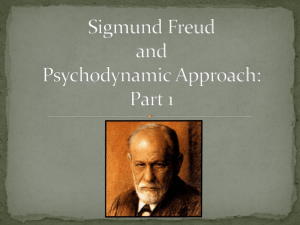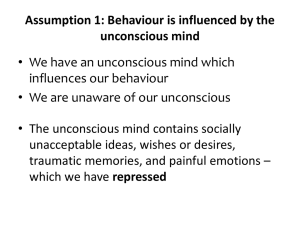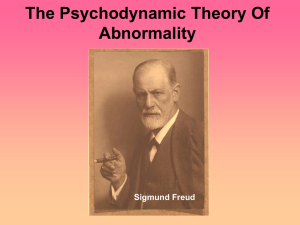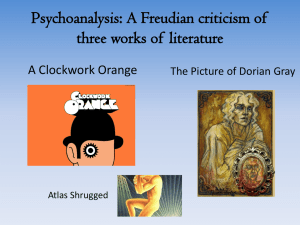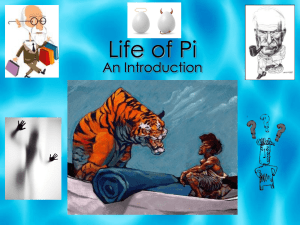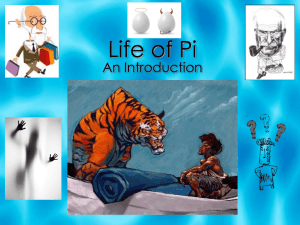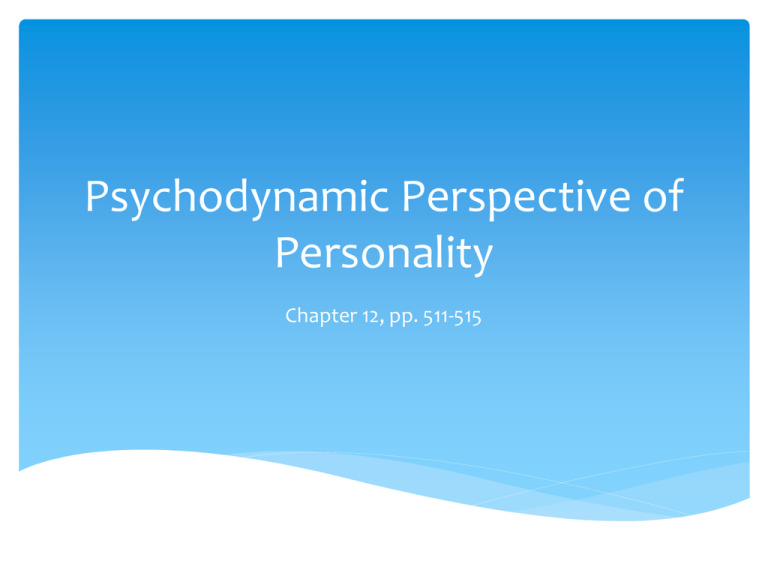
Psychodynamic Perspective of
Personality
Chapter 12, pp. 511-515
Psychodynamic Perspective
Personality is a result of
unconscious psychological
conflicts and how
effectively these are
resolved.
The conflicts originate from
childhood experiences
when instinctive urges and
society’s view of what is
acceptable behaviour often
clash.
Freud’s Theory
Observed patients, his
family and his own
thoughts, feelings and
behaviour.
First developmental theory
of Personality.
He not only attempted to
explain how personality
develops, but also how the
development of personality
occurs throughout the
lifespan.
Freud’s Theory
Believed that the mind is like an iceberg, most of it
hidden below the surface.
Most of the time, we experience only thoughts
feelings and behaviour from the ‘tip of the iceberg’.
Developed three levels of the human mind.
The Conscious Level
The ‘Tip of the Iceberg”
The conscious level is everything we are thinking,
remembering, feeling, sensing or are aware of at this
particular moment.
Ideas and thoughts are constantly flowing in and out
of the conscious mind.
Eg. Your conscious awareness right now might be the
words you are reading or hearing… or how tired you
are...
The Preconscious Level
Just below the surface.
The preconscious contains information which we often
say is at the ‘back of our mind’ and can be brought to the
conscious mind by simply thinking about it.
Think about:
What did you have for lunch yesterday?
What did you learn last lesson?
You just moved these thoughts from your preconscious to
your conscious level of awareness.
The Unconscious Level
Deep below the surface.
We are not aware of unconscious thoughts but they still have
considerable influence of our conscious thoughts and feelings.
It is a storage place in our mind for all the information about
ourselves which is unacceptable to the conscious mind. It holds
unacceptable thoughts, feelings, experiences, images,
impulses, motives and ideas and they are buried.
Freud believed that painful memories, frightening experiences
and emotionally painful thoughts are held in the unconscious
because they are very difficult to bring to our conscious
thoughts. It is not a place for all memories but rather a place for
‘the skeletons in the closet’.
The Iceberg Theory
Conscious
Preconscious
Unconscious
Activity 1. Iceberg Worksheet Part 1.
Labeling the Iceberg
In the space provided on the left
hand side of the iceberg add the
headings in their correct order:
Preconscious
Explanations
Place the correct explanation
statements in the space provided on
the right hand side of the iceberg.
Easily accessible information in the ‘back
of the mind’ but not currently aware of it.
Conscious
Aware of this information at any time.
Unconscious
Hidden and not immediately available.
Answer
Activity 1. Iceberg Worksheet Part 2
Consider these ‘thoughts’ and place them onto your Iceberg in the
correct level, either conscious, preconscious or unconscious.
Answer
Freud’s Structure of Personality
Personality is fully developed
by age 6 but we continue to
refine and expand on this basic
personality structure
throughout the lifespan.
Freud believed that personality
consists of 3 parts which pull
an individual in different
directions creating a conflict,
they are called the id, ego and
superego.
How we resolve this conflict
determines most of our
behaviour and shapes our
personality.
Id.
The Id is a concept and it represents
innate biological needs such as
hunger, thirst, sleep and sex.
The Id is described as a force which
is demanding, impulsive, irrational
and an extremely selfish part of our
personality.
Operates on a Pleasure Principle, it
must have it’s needs met.
If our behaviour was completely
controlled by our Id, we would have
to have our own way all of the time!!
Freud believes that a newborn
babies behaviour is completely
dominated by their Id, they want
everything immediately and must
have their needs met.
Ego.
The Ego develops gradually when
children begin to understand more
about the how the real world
operates, it is the part of personality
which is realistic, logical and orderly.
Operates on the Reality Principle it
tries to ensure the needs of the Id are
met but in a socially acceptable way
and at appropriate times.
Therefore the Ego considers ‘real-life’
restrictions in dealing with Id demands.
E.g. Imagine what would happen if
people expressed their sexual impulses
whenever they ‘popped into their
mind’ regardless of where they are?
Superego.
The Superego is our conscience,
always looking after us, judging
our thoughts, feelings and actions
based on societies morals and
values.
Operates on the Moral Principle,
providing us with ideas of right and
wrong.
Gives us feeling of guilt for negative
behaviour and pride for positive
behaviour. Always aims for
perfection.
The Superego’s main function is to
block the Id and persuade the Ego
to make moralistic decisions.
Summary
The Id is instinctive and
Impulsive, exists in the
unconscious.
The Ego is realistic and
sensible, exists in the
conscious and preconscious.
The Superego is idealistic
and judgmental, exists
across conscious,
preconscious and
unconscious.
Iceberg Worksheet
EGO
SUPEREGO
ID
Activity 2. Role Play
Break into groups of 4-5.
Create a scenario, such as:
Bobby is overweight and is on a diet. Some
close friends invite him out for ice-cream. How
would Bobby’s Id, Ego and Superego respond
to the offer, and how would they persuade
Bobby to behave at the Ice-cream parlor.
You will need 3 group members to ‘act’ as
the Id, Ego and Superego and 1 member
as narrator.
Act out what the Id, Ego and Superego
would ‘say’ and ‘do’ in your scenario and
how they might feel afterward.
Present your role plays to the class
Interaction between Id, Ego and
Superego
The Ego often acts as a mediator
between the Id and Superego.
If the Id is too strong it may develop
a self-centered personality.
If the Ego is too strong it may
develop a personality which is too
practical and not spontaneous.
If the Superego is too strong it may
develop a moralistic and judgmental
personality.
However a balance between the Id,
Ego and Superego will develop a
balanced personality.
Reflection
Which personality structure do you think is your strongest?
What are the potential benefits and disadvantages of this?


